![]()
![]()
![]()
Use LEFT and RIGHT arrow keys to navigate between flashcards;
Use UP and DOWN arrow keys to flip the card;
H to show hint;
A reads text to speech;
257 Cards in this Set
- Front
- Back
|
Difference between proposed and existing contours on a contour map? |
Existing are thin and dashed, proposed are thicker and solid. |
|
|
How is the flow line at the bottom of a pipe indicated? |
By a spot elevation |
|
|
Which direction do swale and drainage ditch contours point? |
Uphill |
|
|
Which direction do coutour lines point along a ridge or crown of a road?
|
Downhill
|
|
|
At which end of a drainage pipe should you indicate an invert elevation?
|
Both
|
|
|
The HPS must be how much lower than the elevation of the object for which the swale is intended?
|
6"
|
|
|
What side are contour lines labeled on?
|
High side/ Uphill
|
|
|
1 acre = how many SF?
|
43,560 SF
|
|
|
1 SY = ? SF27 CF = ? CY1 Mile = Ft |
9 SF 1 CF 5,280 FT |
|
|
What is the rational formula for calculating stormwater runoff?
|
Q=CIAQ=quantity of water in units of cfs (cu. ft. per second) C=Cover factor for the soil and vegetation, decimal with no units (% or rainfall that runs off without infiltrating) I=rainfall intensity (in/hr) A=Area of watershed (acres) |
|
|
How do you determine the boundaries of a Watershed?
|
1. Begin at collection point (lowest pt)2. Trace a line uphill from low pt perpendicular to contours3. when you reach a hilltop or ridge, go back a trace in other direction to top of other side.4.connect 2 lines by following ridge lines and saddle points.
|
|
|
What are the common units for earthworks?
|
cu. yards or cu. meters
|
|
|
What are the three primary methods of calculating volumes of soil for earthworks? |
1. Contour Planes or plans 2. grid cell or borrow pit 3. average end area
P.326 in Landscape Arch Graphics Standards |
|
|
Describe the GRID cell or borrow pit method for earthwork volume calcs. |
Useful for excavations 1Divides site into grid cells. Calculate change in elevation caused by grading plan at each corner of the grid 2. Calc the avg depth of cut and fill for each cell 3.multiply the avg depth of cut and fill by area of each cell. |
|
|
Describe the Average End Area Method of calculating earthwork volume.
|
Usually used for linear objects (roads or golf holes)1.Draw cross sections at regular intervals showing both existing and proposed elevations2. Measure the areas of cut and fill shown at each cross section in square inches and convert to sf.3. average the areas of cut and fill shown between two successive cross sections.4. Multiply the average areas of cut and fill shown b/n two successive cross sections by the distance b/n the cross sections on the plan to convert to cu ft.5. First and last sections are usually cone shaped andare more accurately calculated with V=A/3 x L, where A = base of cone.
|
|
|
Describe the contour planes method for calculating earthwork volume. |
Most common for site plans
1. measure the area shown in cut and fill for each contour on the plan in sq. in. and convert to SF 2. Multiply the area of cut and fill for each contour by the contour interval (depth) to convert to cu. ft. |
|
|
Slope=
|
Rise/ Run
|
|
|
Rise =
|
Slope x Run
|
|
|
Run =
|
Rise/ Slope
|
|
|
What is sheet drainage?
|
Surface water that drains across a plane.
|
|
|
What type of grading is generally used for athletic fields?
|
Surface water that drains across a plane.
|
|
|
What type of drainage should be used for athletic fields on steep topo?
|
sheet and swale drainage together.
|
|
|
What will RIM EL represent for a drain inlet on a warped plane?
|
the lowest point for the warped plane.
|
|
|
typical width of parking space?
|
9'
|
|
|
What should be added to indicated direction of surface runoff
|
flow arrows
|
|
|
what are the 3 parts of a swale?
|
hps, a cross slope and longitudinal slope
|
|
|
What is an acceptable range for longitudinal swale slope?
|
2-4%
|
|
|
Where should a HPS be located?
|
at the saddle point.
|
|
|
What is the minimum depth of a swale?
|
6"
|
|
|
What are the 3 parts of a retention pond?
|
collection basin, dam/embankment, and a swale connection opposite the dam
|
|
|
What height should a retention pond embankment/dam be made?
|
6" above the pond's highest elevation
|
|
|
How do you determine the correct height for berm visual measurements?
|
Add eye height to ground elevation. then add 6" to final calc of height for berm to be safe.
|
|
|
what slope should swales warp a berm?
|
max allowable slope.
|
|
|
what shape will a concrete road create topographically.
|
A chevron.
|
|
|
What shape will an asphalt road create topographically?
|
A parabola
|
|
|
what is a typ specified height for a curb?
|
6-8"
|
|
|
Below what % grade is a slope considered accessible?
|
5%
|
|
|
Above what % slope in the existing topography will stairs/ramps be needed?
|
5%
|
|
|
What are the three components of stair design?
|
riser, tread and landing
|
|
|
What are the min and max # of risers for a set of stairs in the landscape?
|
min 3, max 10 per set; or 5' of vertical change before a landing
|
|
|
What is the typical height of a riser
|
4 min.-7"
|
|
|
typical tread length and riser height?
|
tread: 10-18" longriser: usually 6" high
|
|
|
Wash on tread?
|
2% (does not need to be included in the calculations for stairs)
|
|
|
What is a common formula to give a workable riser to tread length?
|
2R+T=26 INCHES
|
|
|
What is the minimum length of a stair/ramp landing?
|
5' of clear space between railings or walls. same width as stairs
|
|
|
how far must a railing extend at the top and bottom of a set of stairs?
|
1' at top; 1'+1 tread length at bottom of stairs.
|
|
|
What is the width req'd to determine stair railing placement?
|
One handrail for every 2.5' (30in) of a width of stair; ie. 3' wide stairs require one rail on one side only. a 6' wide stair requires 3 rails, one on each side and one in the middle.
|
|
|
When are handrails required for stairs?
|
for all sets with more than 3 risers
|
|
|
What is the required height of handrail of a ramp?
|
34-38" above riser
|
|
|
What are the min and max allowable longitudinal slopes for a ramp?
|
min 5% (20:1), max 8.33% (rise: run 1:12)
|
|
|
What are the max height and length for a ramp run before a landing?
|
length: 30', height:30"
|
|
|
What is the cross slope for most ramps?
|
2%, so landing will be warped planes.
|
|
|
What is the min clear width b/n handrails for one way and two way ramps?
|
one way: 3'two way:5'
|
|
|
If a cheek wall is shown for a ramp, what height will it probably exceed?
|
42", the max height above finished grade.
|
|
|
What must a cheek wall include at the top?
|
A safety railing in addition to the hand rails req'd for the entire length of the ramp on BOTH sides. Hand rail may be attached to safety railing, cheek wall or ramp
|
|
|
What height must a hand rail maintain above a ramp?
|
34-38" and must extend past the ramp 1' at both top and bottom. when meeting an existing walk a 1' level distance is included ramp length for extension of hand rail so it does not stick out.
|
|
|
What amount must be added to a spot elevation to determine the FFE of a building when calculating from a point outside the building?
|
1" (0.08")
|
|
|
What three variables should be know when doing pipe calculations?
|
INV IN, pipe diameter and slope.
|
|
|
What are INV IN and INV OUT?
|
INV IN: the spot elevation at the base of a pipe that is flowing to a catch basin.INV OUT: the spot elevation at the base of a pipe that is flowing AWAY from a catch basin.
|
|
|
A pipe that is flowing away from a catch basis is often (but not always) ___________ than a pipe flowing to a catch basin.
|
bigger
|
|
|
How high should and INV OUT for a pipe be above an existing stream or channel to ensure positive flow and prevent backwash?
|
6"
|
|
|
What are the 2 main objectives of SWM?
|
1. reduce downstream flooding2. reduce flooding damage by restricting floodplain development.
|
|
|
What is BMP
|
Best Management Practice for SWM
|
|
|
Define BMP
|
Measures which have been developed to control, store and/or treat storm water runoff from developed areas for the purpose of reducing flooding or removing pollutants while maintaining or enhancing env. quality.
|
|
|
What is the goal of BMP?
|
to control non-point source pollution while providing effective BMP.
|
|
|
What is a retention pond/basin?
|
A wet pond or basin which contain a PERMANENT pool of water.
|
|
|
What are the main features that need to be considered when designing a retention basin?
|
1. Maximize flow length b/n inlet and outlet. suggested width to length ration of 3:12. The pond should expand gradually in the direction of flow.3. Pool depth should be b/n 4-8', with a level safety bench provided at least 10' wide by 1'deep
|
|
|
What is a detention basin?
|
a dry basin, used as a means of controlling peak discharge rates through the temporary storage of storm runoff. Outflow rates are set at or below pre-development rates and flow is metered out of the basin until no water remains.
|
|
|
considerations for detention basin design?
|
1. maximize flow length from inlet to outlet2. side slopes of basin should be LESS than 3:1, with the floor having a min slope of of 2% (think swale)3. An access way of at least 10' wide with a slope of 5:1 or less should be provided for maintenance equipment.
|
|
|
Soils with a high silt and fine sand content have a __________ erodibility potential.
|
high
|
|
|
Soils with increased clay and organic content have __________ erodibility potential.
|
Lower
|
|
|
In what situation might a reverse crown be desired on a road?
|
An alley, to channel water away from yards or service buildings.
|
|
|
what is the difference between a ditch and a swale?
|
A ditch is usually deeper and narrower than a swale is is typically not vegetated. Depth is usually 2 feet or more. Swales are preferred, but ditches may be necessary in tight spaces.
|
|
|
What would be the least amount of slope allowable on a playing field if paved or closely mowed turf?
|
0.5%
|
|
|
What information is contained in a finished grading plan?
|
1.Ex and Prop. contour info, bldgs, structures, utilities2. Proposed walks, roads, parking lots3. Property lines with bearing and dimensions4. location and extent of tree protection5. ALL spot elevations6. Max and min slopes with downhill arrows7. storm water drainage inlets and manhole,with designation for rim and invert elevations8. Stormwater piping with designation for material, diameter length and slope9. subsurface drainage systems
|
|
|
What amount is typically added to cut and fill calculations to compensate for shrinkage factor?
|
5-10%
|
|
|
What other elements must be accounted for in cut and fill calculations other than proposed and existing grades?
|
Calculations must account for the amount of existing surface material that is removed and the amount of new surface material constructed. i.e. the finished grade of a road is not the final depth of excavation, you must also account for all sub grade depths as well. Also, topsoil will need to be stripped prior to new construction fill.
|
|
|
Which 4 grading elements need both a RE and IE?
|
Drain inlet, storm drain, manhole and catch basin.
|
|
|
What are the two major phases of roadway design?
|
1. alignment of the road (horizontal and vertical direction)2. grading the adjacent landscape to the road edge
|
|
|
List methods of fastening or connecting wood to:1. wood2. concrete3. masonry
|
1. Nails, wood screws, bolts2. Lead anchors and lag bolts gals. angles3. Lead anchors and lag bolts
|
|
|
List methods of fastening or connecting asphalt to:1. Concrete2. Aggregate3. Asphalt
|
1. tack coat of emulsified asphalt2. prime coat of cutback asphalt3. tack coat of emulsified asphalt
|
|
|
List methods of fastening or connecting Masonry to:1. Concrete2. Masonry
|
1. Mortar, masonry anchors, grout2. Mortar, masonry ties and/or anchors
|
|
|
List methods of fastening or connecting metal to:1. Masonry2. Concrete3. Metal
|
1. grout and galvanized surface2. grout and galvanized surface3. make sure of galvanized surfaces to prevent corrosion
|
|
|
What factors affect a nails holding power?
|
diameter, length, shape and surface.
|
|
|
What materials are common nails usually made of?
|
Steel or aluminum.
|
|
|
Describe how nails are sized and measured
|
Length (inches) or Penny (another length unit, d, one penny is approx 1/2"), gauge (diameter; The bigger the number, the thinner the nail)
|
|
|
What is the difference between joist hanger nails and common nails?
|
Joist hanger nails are shorter than common nails of the same gauge or penny.
|
|
|
Describe how concrete handles compressive and tensile forces.
|
Concrete is inherently strong in compression, but steel reinforcement is required to handle tensile and shear stresses.
|
|
|
What is Portland Cement?
|
a hydraulic cement made by burning a mixture of clay and limestone in a rotary kiln and pulverizing the resulting clinker into a very fine powder.
|
|
|
What are the components of concrete?
|
mixture of aggregate, portland cement, water and sometimes admixtures.
|
|
|
How many types of Portland Cement are there?
|
Five
|
|
|
What factors limit coarse aggregate size in reinforced concrete?
|
the size of the section and the spacing of the reinforcing bars limit aggregate size. 1/3 the depth of a slab, 1/5 the thickness of a wall or non-reinforced elements, or 3/4 of the clear space between the bars and the form work.
|
|
|
What is the purpose of Air-entraining concrete admixtures?
|
Should be used under all conditions involving severe exposure to frost/thaw temperatures. They disperse microscopic air bubbles to increase workability and resistance to cracking from freeze/thaw.
|
|
|
What type of water should be used for mixing concrete?
|
Potable water. Avoid water with sulfates, salts or deleterious substances.
|
|
|
List 4 ways to reduce water penetration in concrete.
|
1. Keep water:cement ratio to less than 0.5 by weight2. carefully treat all joints and cracks to prevent leaks3. add chemical and admixtures to reduce water penetration4. apply waterproof surface seal or compound.
|
|
|
Three reasons for controlling the setting time of concrete are:
|
1. reduce the setting time when below freezing2. increase working time when temps are hot3. control bleeding, or the movement of water to the surface of freshly placed concrete.
|
|
|
What three factors are controlled by the water:cement ratio?
|
Strength, durability and water tightness
|
|
|
The compressive strength of concrete is ___________ proportional to the ratio of water to cement.
|
Inversely. Too much water makes it weak and porous after curing. too little water makes concrete dense and unworkable. Best ratio of water:cement is usually 0.45 to 0.6
|
|
|
How is concrete usually specified?
|
According to the compressive strength it will develop within 28 days after placement.
|
|
|
What two tests are used for concrete to determine strength and workability?
|
1. Slump test: determines consistency and workability of freshly mixed concrete.2. Compression test: uses a hydraulic press to measure the max load a 6" test cylinder can support in axial compression before fracturing.
|
|
|
What are several uses/benefits of steel reinforcement of concrete?
|
1. absorb tensile, shearing and sometimes compressive stresses2. ties vertical and horizontal elements3. reinforces the edges around openings4. minimizes shrinkage and cracking5. controls thermal expansion and contraction
|
|
|
How is rebar sized?
|
the bar number refers to its diameter in eighths of an inch; e.g. #5 bar is 5/8 in diameter, so #4 rebar is 1/2"
|
|
|
What is another name for common brick?
|
Building brick; not specially treated for color or texture.
|
|
|
What is Face Brick?
|
made of special clays for facing a wall, often treated to produce the desired color and surface texture.
|
|
|
How quickly should ready-mixed concrete be delivered and placed after cement has been added to the mixture?
|
90 minutes.
|
|
|
What must be done to the subgrade and forms prior to pouring concrete?
|
they must be moistened to prevent extraction of water from the concrete. forms should also be treated with a non-staining release agent for easier removal.
|
|
|
What are the three most common joints used in concrete construction?
|
1. isolation or expansion joints2. Control or contraction joints3. Construction joints
|
|
|
Which concrete joint extends the full depth of the concrete?
|
Isolation (expansion) joints; to provide lateral movement between slabs or other fixed structures.
|
|
|
What is the purpose of Control (contraction) joints?
|
to restrict the cracking of the concrete to predetermined locations. Should be 1/4-1/3 depth of concrete. if tooled, this is done during the finishing of the concrete. If sawed, this is done within 12-24 hours of finishing.
|
|
|
What are construction joints?
|
constructions joints provide places where casting of concrete can be stopped during construction. They may contain tie bars, slip dowels, and/or keyways for load transfer.
|
|
|
What are the spacing requirements for control joints?
|
for a 4"thick or more, should have control joints 8-10' apart, but never more than 20" apart in any direction. Make square if possible. Square shape when possible.
|
|
|
All joints, except control joints should be filled with what type of material?
|
fiber, wood, metal or other materials to provide a smooth and safe wearing surface.
|
|
|
What are the most common methods for retaining the moisture in concrete for proper curing?
|
1. wet curing2. waterproof paper or plastic sheets3. sprinkling or ponding of water4. curing compounds
|
|
|
What is the best temperature range for curing concrete?
|
50F-85F (10-29C)
|
|
|
How long should concrete be protected from freezing weather during installation?
|
1-2 weeks
|
|
|
What should be used to retain moisture during the curing process on colored concrete?
|
A wax-based curing compound that is clear or the same color as the colorant should be used, because waterproof paper or plastic sheeting will result in discoloration.
|
|
|
What is the purpose of a concrete seal or glaze?
|
to provide a waterproof sealer which prevents or reduces moisture and chloride penetration.
|
|
|
What are the three common types of concrete seal/glaze?
|
1. Sealer and curing compound-applied on damp concrete or used on fresh concrete as a non-fugitive curing compound that will provide continuous protection.2. Glazier-sealer: a compound that brings out the natural color of slate, brick, stone and concrete, while providing moisture and chloride protection.3. Deck coating: allows water to evaporate, but still protects. UV resistant. Do not apply until concrete is thoroughly dry.
|
|
|
What is efflorescence?
|
a white powdery deposit that forms on an exposed masonry or concrete surface, caused by the leaching and crystallization of soluble salts from within the material. Reducing moisture absorption is the best assurance against efflorescence.
|
|
|
What are the standard nominal dimensions of a brick?
|
4" wide, 2 2/3" high, 8" long (includes manufactured width of unit plus a mortared joint (3/8-1/2"))3 courses = 8 inches.
|
|
|
What are the 6 brick unit positions? TSS pp. 840-5
|
stretcher, header, soldier, rowlock stretcher, rowlock, sailor
|
|
|
List 3 mortar joint types with good weatherability.
|
concave or rooded and set in slightly ("("), V-shaped (<), and grapevine ({)
|
|
|
List four mortar joint types with Fair weatherability.
|
Flush and rodded (concave not set in); weathered (\), ruled (small V inset); flush or plain cut.
|
|
|
List 5 mortar joint types with poor weatherability.
|
Beaded (}), Raked (inset flat); struck (/); extruded (convex protruding); scintled (rough extruded)
|
|
|
What does brick grading designate?
|
the durability of a brick unit when exposed to weathering in one of 3 U.S. weathering regions. Brick is graded according to its compressive strength, max water absorption and max saturation coefficient.
|
|
|
What is SW brick? |
suitable for exposure to severe weathering.
|
|
|
What is MW and NW brick?
|
MW: suitable for exposure to moderate weathering.NW: suitable for negligible weathering as in back up or interior masonry.
|
|
|
What is a Norman Brick?
|
4x2 2/3x12" long
|
|
|
What are Concrete Masonry Units? (CMU)
|
precast units of Portland cement, fine aggregate and water.
|
|
|
What are the two grades of concrete block?
|
N: loadbearing CMU suitable for use both above and below grade in walls exposed to moisture or weather.S: loadbearing CMU limited to use in above grade, in exterior walls with weather-protective coatings, or in walls not exposed to moisture or weather.
|
|
|
What is the difference between Type I and II CMU?
|
Type I is manufactured to a specified limit of moisture content to minimize shrinkage that can cause cracking. Type II has no specified MC.
|
|
|
What is the standard nominal dimension of a CMU stretcher block?
|
8x8x16"
|
|
|
Describe Granite and its uses.
|
Granite is difficult to finish and relatively expensive. Typical uses include building veneer, pavers, curbing, crushed stone, and granite dust.
|
|
|
Describe Limestone and its uses.
|
Limestone is chemically reactive and should be waterproofed or isolated by a waterproof membrane if it touches the ground to prevent staining. Typical uses include building veneer, ashlar or flagstone walls, pavers, crushed aggregate and limestone dust.
|
|
|
Describe marble and it's uses.
|
Available in 4 quality grades and chemically reactive. Uses: veneer, monuments, and crushed aggregate.
|
|
|
Describe Sandstone and its uses.
|
Serves well as a non-slip walking surface. Uses: veneer, pavers, cut stone and rubble.
|
|
|
Describe Slate and its uses.
|
Strong and durable, high tensile strength, lots of colors. Uses: flagstones for paving or walls, and roofing slate.
|
|
|
How do air content, flow and time affect the bond strength of mortar?
|
1. as the air content is increased, bond strength decreases.2. as the flow increases, the bond strength increases.3. as the lapsed time between the spreading of the mortar and the laying of units increases, the bond strength decreases.
|
|
|
What are the three components of mortar?
|
cementitious material. clean well-graded sand, and water.
|
|
|
What 4 plastic properties does mortar possess?
|
Workability, water retention, initial flow, flow after suction.
|
|
|
What determines the compressive strength of mortar?
|
the amount of portland cement in the mix.
|
|
|
What are the types of reinforcement used in masonry construction?
|
wire reinforcement, wall ties, anchors, dowels and reinforcing bars.
|
|
|
How can corrosive situations be prevented when aluminum is used?
|
by applying bituminous or zinc chromate prime on metal.
|
|
|
What is steel?
|
various Iron based alloys having a carbon content less than that of cast iron and more than wrought iron. Qualities: strength, hardness and elasticity.*Because steel is normally subject to corrosion, steel must be painted, galvanized or chemically treated for protection against oxidation.
|
|
|
What is alloy steel?
|
carbon steel to which various elements, such as chromium, cobalt, copper, manganese, etc. have been added in a sufficient amount to obtain a particular physical or chemical property.
|
|
|
What is Stainless Steel?
|
ntains a min of 12% chromium, sometimes with nickel, manganese, or molybdenum as additional alloying elements, so as to be highly corrosion resistant.
|
|
|
What are 3 non-ferrous metals usually used in construction?
|
Aluminum, copper and lead.
|
|
|
What is brass?
|
an of various alloys consisting essentially of copper and zinc.
|
|
|
What is galvanic action?
|
occurs between two dissimilar metals when enough moisture is present for electric current to flow. This electric current will tend to corrode one metal while plating the other.
|
|
|
The more water used in a portland cement concrete mixture, the lower will be the __________ strength of the resulting mix.
|
compressive
|
|
|
An asphalt concrete mixture that may be spread and compacted at normal air temperature is called?
|
cold-mix asphalt.
|
|
|
The portland cement mortar that should NOT be specified for use in exterior locations exposed to freezing temperatures is?
|
Type O.
|
|
|
An application of emulsified asphalt that is used to provide a bond between two asphalt concrete courses is called?
|
A tack coat.
|
|
|
The test used to measure the consistency between batches of portland cement concrete is the
|
Slump test
|
|
|
Adding water to a mortar mix improves its ?
|
tensile bond strength
|
|
|
Which admixture might be added to a portland cement concrete mixture when it is being poured for an exposed aggregate walkway on a hot day?
|
a retardant.
|
|
|
What is the common size for a mortar joint for masonry walls when using a standard module brick?
|
3/8"
|
|
|
An application of a cutback asphalt to an aggregate base course to prepare the base for subsequent courses of asphalt concrete paving is termed a ______ coat.
|
Prime
|
|
|
A brick masonry patter in which every other brick in the wall is a header is termed?
|
Flemish bond
|
|
|
What is a wythe?
|
a continuous section of masonry that is one unit in thickness.
|
|
|
What is a structural bond?
|
a masonry pattern in which the individual units or wythes are interlocked to cause the entire assembly to function as single structural unit.
|
|
|
What is the term for a piece of brick?
|
a bat.
|
|
|
A material used to bond steel rebars to concrete block in a retaining wall is?
|
Grout
|
|
|
Edge restraints are required for pavements set up what kind of base course?
|
Flexible.
|
|
|
List the four items that should always be addressed on a construction detail.
|
Materials, finishes, fasteners and dimensions
|
|
|
What CSI divisions are used for earthwork and exterior improvement?
|
31 and 32
|
|
|
What is the purpose of curing concrete?
|
to allow hydration to continue.
|
|
|
True or False? typically grouts are high in tensile strength, but low in compressive strength.
|
True
|
|
|
Six courses of standard module brick = inches in height?
|
16"
|
|
|
What type of concrete block is most commonly used for landscape applications?
|
Hollow load bearing concrete block
|
|
|
How do you calculate board feet?
|
(# of pieces)x(width in inches)x(height in inches)x(length in feet)/(all divided by 12)
|
|
|
What are the 5 types of portland cement?
|
Type I: normal general purpose, usually provided unless otherwise specifiedType II: moderate sulfate resistanceType III: high early strengthType IV: low heat of hydrationType V: high sulfate resistance
|
|
|
How is compressive strength of concrete measured?
|
in psi after 28 days of curing
|
|
|
What is the tip psi specified for concrete?
|
3000-5000 psi
|
|
|
What is the most common grade of rebar used in landscape construction?
|
Grade 40: 40,000psiGrade 50: 50,000psi min strength
|
|
|
How is welded wire mesh specified?
|
first # is longitudinal spacing, second # is transverse spacing, third # is wire size (gauge)e.g. 6"x6" #10 WWM***The higher the gauge the thinner the wire!!!!!!
|
|
|
What is cutback asphalt?
|
Asphalt cement which has been liquified by blending with petroleum solvents. Upon exposure to the atmosphere, the solvents evaporate, leaving the asphalt cement to perform its function of cementing and waterproofing. There are 4 types.
|
|
|
What are the 4 types of cutback asphalt?
|
Rapid Curing (RC)- asphalt cement and a naptha or gasoline type solvent of high volatilityMedium Curing (MC)- Asphalt cement and a kerosene type solvent of medium volatilitySlow Curing (SC)- Asphalt cement and an oil of low volatilityRoad Oil- a heavy petroleum oil, very slow curing
|
|
|
What is the purpose of cutback asphalt?
|
Like emulsions, cutbacks are used because they reduce asphalt viscosity for lower temperature uses (tack coats, fog seals, slurry seals, stabilization material). Similar to emulsified asphalts, after a cutback asphalt is applied the petroleum solvent evaporates leaving behind asphalt cement residue on the surface to which it was applied. A cutback asphalt is said to “cure” as the petroleum solvent evaporates away. The use of cutback asphalts is decreasing because of (Roberts et al., 1996[1]):Environmental regulations. Cutback asphalts contain volatile chemicals that evaporate into the atmosphere. Emulsified asphalts evaporate water into the atmosphere.Loss of high energy products. The petroleum solvents used require higher amounts of energy to manufacture and are expensive compared to the water and emulsifying agents used in emulsified asphalts.In many places, cutback asphalt use is restricted to patching materials for use in cold weather.
|
|
|
What is a tack coat?
|
A light application of an emulsified asphalt used to ensure a bond between two asphalt pavement courses.
|
|
|
What is emulsified asphalt?
|
An emulsion of asphalt cement and water. When applied, the water evaporates, leaving the asphalt to perform it's function.
|
|
|
What is a prime coat?
|
An application of low viscosity cutback asphalt to an absorbent surface such as crushed stone or gravel. It is used to prepare the base course for an asphalt pavement. The asphalt penetrates into the base, plugs the voids, hardens the top and helps bind the base material to the overlying asphalt pavement.
|
|
|
What is the max depth of an asphalt lift?
|
lift=layer. usually 4-6"
|
|
|
What is the difference between Primer Meridian, Baseline and Principal Meridian?
|
Prime Meridians are north-south lines (lines of longitude), at which longitude is defined to be 0°. The Prime Meridian starts at the North Pole and extends south to the South Pole. Baselines are lines that extend east-west. Principal meridians are the true north-south lines that run through the initial point of the area that is being covered.http://www.landsurveyors.com/resources/land-surveying-measurement/
|
|
|
What is the surveying definition of a township?
|
Each 24-mile tract is divided up into 16 townships. Townships are roughly 6 miles x 6 miles. each township is now divided into 36 sections, a piece of land roughly 1 square mile x 1 square mile, or approximately 640 acres. This process is also used in defining corners and running lines from the southeast corner of the township. Each of the 36 sections is then divided into 16 forties. These forties are further subdivided, and subdivided, and subdivided.
|
|
|
How many acres is a square mile?
|
640
|
|
|
What is a geodetic survey?
|
Geodetic surveys are very precise and cover large areas.These require the curvature of the earth to be taken into consideration and require additional land survey techniques such as triangulation, trilateration and astronomical direction fixing.
|
|
|
What is a plane survey?
|
Plane surveys consider the surface of the Earth to be a flat plane, and curvature is not taken into consideration. Techniques for plane surveys include plane trigonometry and plane geometry. These types of land survey techniques are only used in small areas.
|
|
|
What are the 5 fundamental land surveying techniques?
|
triangulationtrilaterationtraverselevelingradiation
|
|
|
What are the three functions of a precast pavement base course?
|
1. support the expected traffic load2. provide drainage3. provide ground swell protection
|
|
|
What are the 3 types of bases used for precast pavers?
|
Rigidsemi-flexibleflexible
|
|
|
What is a rigid base?
|
usually for pavements that will support heavy vehicular traffic. The consist of a prepared sub grade on which a portland cement concrete slab is installed.
|
|
|
What is a semi-flexible base?
|
a base course consisting of one or more courses of an asphalt based paving material. suitable for ped and vehicular use depending on depth of the base.
|
|
|
What is a flexible base?
|
one or more layers of crushed stone or gravel over a well compacted sub grade. Flexible bases are usually less expensive and easier to install. vehicular of ped traffic depending on depth.
|
|
|
What are the three types of setting beds?
|
1. rigid: mortar or grout used to bond the pavers to the base course. Type M mortar usually used for exterior pavements because of its high compressive strength and durability. 1/2-2" deep. Only use over rigid bases to prevent cracking.2. semi-flexible: mixture of asphalt cement and sand. May be used over either rigid or semi-flexible beds. Tack coat on top of asphalt layer under pavers3.flexible: 1-2 inch depth of bedding sand or stone dust. may be used over any base course system, but only used with a flexible jointing system.
|
|
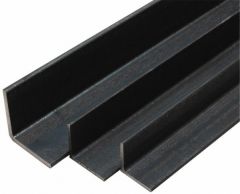
An L-shaped, steel bar or structural steel member used to make a frame rigid |
Angle Iron |
|

A cementous material, solid or semisolid, made primarily or bitumens which occur in nature. Can also be created by refining petroleum. Used as a roofing sealant or paving surface. |
Asphalt
|
|
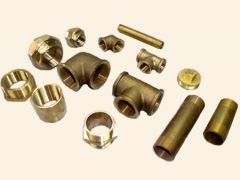
Any pipe constructed form any copper allow containing zinc as its principal alloying element. Often used in plumbing where rust is a factor. |
Brass Pipe
|
|
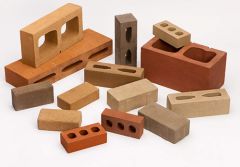
A solid or hallow masonry unit made from clay or shale, molded into a rectangular shape with plastic, then burnt in a kiln. |
Brick
|
|

A door or window hinge consisting of two rectangular metal plates which are joined with a pin, fastened to butting surface such as the face of a jamb or edge of a door. |
Butt Hinge
|
|
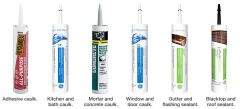
A resilient mastic compound used to seal cracks and fill joints in order to prevent leakage or provide waterproofing. |
Caulk
|
|
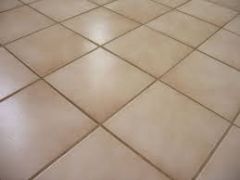
A thin, precast product composed primarily of clay that has been fired to a high degree to prevent moisture absorption. |
Ceramic Tile
|
|
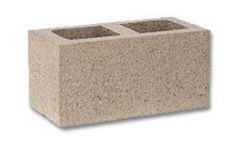
A block or brick cast of portland cement and suitable aggregate with or without admixtures. |
Concrete Masonry Units (CMU)
|
|
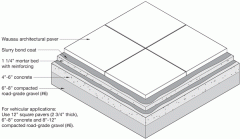
A solid concrete brick used to create a paved surface. Used with or without grout. |
Concrete Pavers
|
|

A pipe constructed of a lustrous metal that is highly ductile, malleable, and resistant to corrosion. Used for downspouts, interior water lines, and weep holes in retaining walls. |
Copper Pipe
|
|
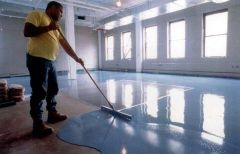
A class of synthetic, thermosetting resins which produce tough, hard, chemically resistant coatings and are excellent adhesives. Used in the landscape as a cementing agent for pavement toppings. |
Epoxy |
|
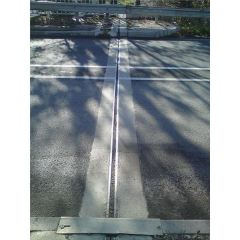
Asphalt impregnated fiber strip used to provide waterproof separation between adjacent structural elements. |
Expansion Joint Material
|
|
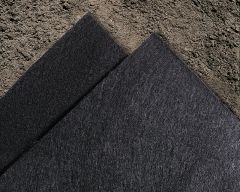
A geotextile material, designed to allow water to pass through while retaining fine particulate matter. Common uses for silt fences, underground drains, and behind retaining walls. |
Filter Fabric
|
|
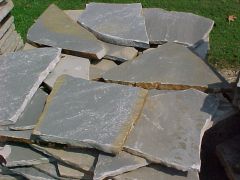
A flat stone usually not more than 4 inches thick used for outdoor paving. |
Flagstone
|
|
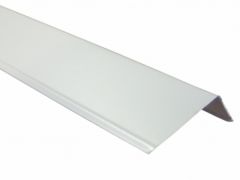
A thing, impervious sheet metal placed in construction to prevent water penetration and or provide water drainage especially between roof and a wall and over exterior door openings and windows. Typically made of aluminum or stainless steel. |
Flashing
|
|

Galvanized sheet metal used for windows or door inlets, bracing for wood deck posts, or other connections. |
Flat Steel
|
|

Assembly of a nut, bolt, and a washer. |
Carriage Bolt Assembly
|
|
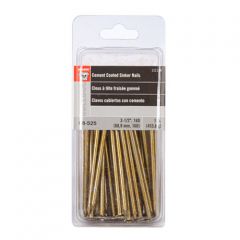
Nail coated with cement to increase its holding power |
Cement Nail
|
|
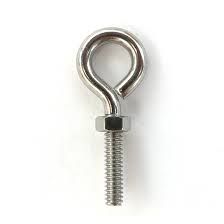
A bolt having a head in the form of a loop. Commonly used for hanging applications. |
Eye Bolt
|
|
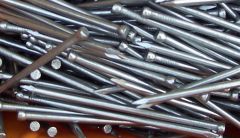
A slender nail made of finer wire than other nails. Has a head type that allows it to be set below the surface of wood. |
Finish Nail
|
|
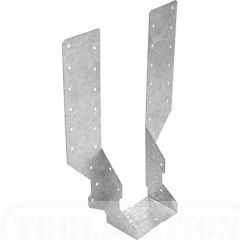
A metal angle or strap used to fix a joist to a beam or girder. |
Joist Hanger
|
|
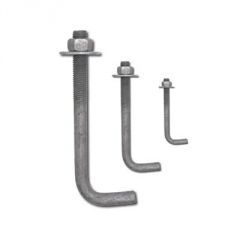
A steel bolt shape that is usually fixed within a structure at construction with the threaded portion out. Used to secure frameworks, timber, or machinery bases, etc. Can also be used in exterior posts to attach a metal post to a concrete footing. Has more strength that embedding a standard bolt |
L-Shaped Bolt Anchor Assembly
|
|
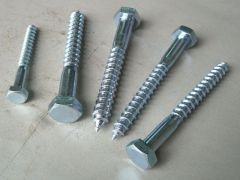
A bolt having a hex head and course pitched thread. Used for connecting wood members where both ends of the bolt are not accessible. |
Lag Screw / Lag Bolt
|
|
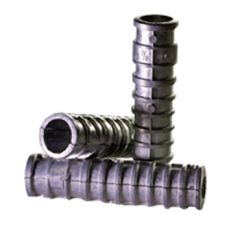
A lag bolt anchoring device that, when combined, swells as the bolt is tightened through an expandable slot. Used in masonry walls for attaching timber. |
Lag Bolt and Expansion Sheild
|
|

A lag bolt used in combination with an anchor that has a lead sleeve surrounding it. The sleeve expands as the bolt is tightened. |
Lag Bolt with Lead Shield
|
|

A bolt with a wedge shaped end inserted into a hole then fastened inside by pouring melted lead or concrete into the hole. |
Lewis Bolt
|
|
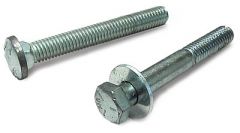
A threaded bolt having a straight shank and conventional head. Requires the use of a nut and two wrenches. Used in a combination with a washing instead of a carriage bolt when there is more load. |
Machine Bolt
|
|
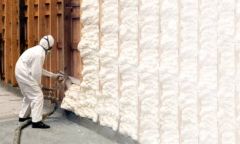
Insulation that is sprayed on and provides an airtight barrier in walls. |
Foam Insulation |
|

The process of coating steel or iron with zinc to prevent rust in conditions that will be affected moisture. |
Galvanizing
|
|
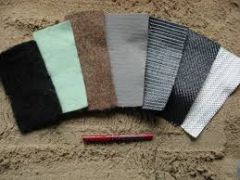
Fabric that is often used in conjunction with soil to protect, separate, or prevent erosion |
Geotextiles
|
|
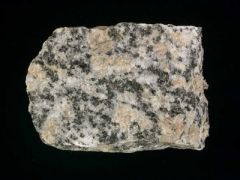
An igneous rock having crystals or grains of visible size. Consisting mainly of quartz, feldspar, and mica or other colored minerals. |
Granite
|
|

A coarse granular aggregate, larger than sand, formed either by the flow of water in streams or man-made by crushing larger stones. Used to provide drainage (behind retaining walls), prevent capillary movement of water (beneath footings or pavements), or to add bearing capacity strength in low bearing-capacity soils. |
Gravel |
|

Mortar containing a considerable amount of water so that it has the consistency of a viscous liquid, permitting it to be poured or pumped into cracks, joints, and cores within masonry walls. It is high in tensile bond strength, but low in compressive strength. |
Grout
|
|
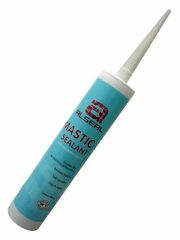
A dough-like heavy adhesive compound; a putty-like sealant. |
Mastic
|
|
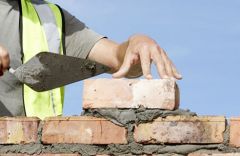
A mixture of cement, sand, water, and lime used to bond together precast masonry units. |
Mortar
|
|

Any of a variety of materials, usually organic but also including gravel or stone dust, that is used to protect plant roots from severe cold or heat, to help retain soil moisture, and to hinder growth of invasive plants. |
Mulch
|
|
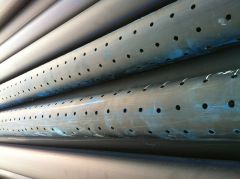
Pipe constructed of polyvinyl chloride , usually corrugated, with slits used to collect water for drainage applications. Often embedded in gravel and buried to absorb run off. |
Perforated PVC Pipe
|
|
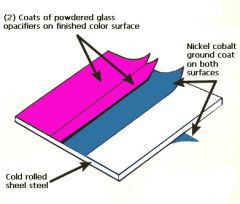
An inorganic metal oxide coating, bonded to metal or ceramic tile by fusion at temperatures over 800 degrees F. |
Porcelain Enamel
|
|
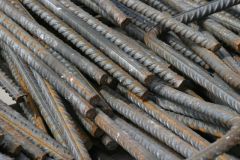
Steel bar having ribs to provide greater bonding strength when used as reinforcing in concrete. |
Rebar
|
|
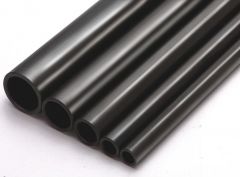
Hollow steel pipe, commonly used for safety handrails on exterior steps and ramps. Common installation method is by drilling holes in the concrete and bonding the tubing to the concrete with grout. |
Round Steel Tubing
|
|
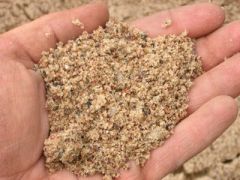
Granular material that passes through a 3/8" sieve. |
Sand
|
|
|
A mixture of mineral soil, Portland cement, and water used to make a hard surface. Used to strengthen the bearing capacity of a soil for paving or retaining walls. It is also sometimes used as a simple pavement by itself for trails. |
Soil Cement
|
|
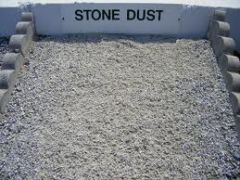
Rock selected or processed by shaping, cutting, and sometimes finishing for construction uses. Stone Dust - Pulverized stone, sometimes used as a substitute for sand. |
Stone
|
|
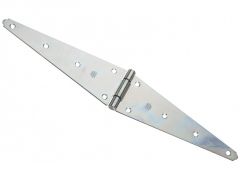
A surface mounted hinge with long flaps of metal on each side by which it is secured to a door and adjacent post, frame, or wall. |
Stra Hinge
|
|
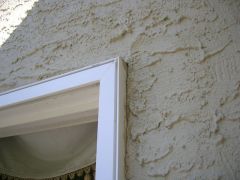
An exterior finish, often textured, composed of portland cement, lime, and sand mixed with water. Installed with at least two coats over a masonry wall, it is used for fine decorative work. Pigments may be mixed into the final coat, or it can be painted. Forms a durable, nearly impervious finish. |
Stucco |
|
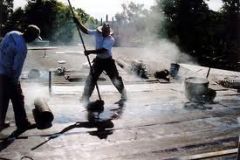
A black hydrocarbon, obtained by the distillation of coal or wood. Sometimes used as a waterproofing agent, although asphalt is more common. |
Tar
|
|
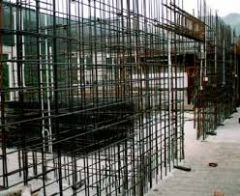
Use of steel rebars at regular intervals in a poured concrete or masonry wall. If used in a masonry wall, the rebars are bonded to the masonry with grout. |
Wall Reinforcement
|
|

The process by which objects are made impervious to water, usually with an application of asphalt. Below grade portions of solid masonry retaining walls and pools are examples of applications that may need to be waterproofed. |
Waterproofing
|
|
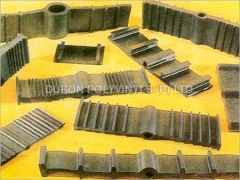
A diaphram used across a joint to prevent the passage of water. Commonly used where pipes extend through pool walls or floors. |
Waterstop
|
|
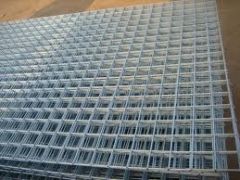
A series of longitudinal and transverse wires, arranged at right angles to each other, and welded together at each intersection. Used as reinforcement in concrete paving to hold cracks tightly together. Specified the wires (in inches) and the gauge (wire diameter). Common sizes are 6x6 #10, 6x6 #8, 4x4 #10, and 4x4 #8. |
Welded Wire Mesh
|
|
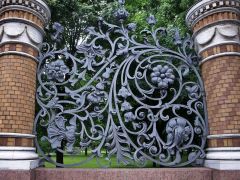
A commercially pure iron of fibrous nature, valued for its corrosion resistance and ductility. Used for decorative fencing and gates. True wrought iron is shaped by hammering. |
Wrought Iron
|
|
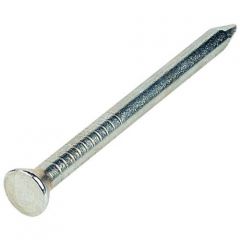
A commercially pure iron of fibrous nature, valued for its corrosion resistance and ductility. Used for decorative fencing and gates. True wrought iron is shaped by hammering. |
Masonry Nail
|
|
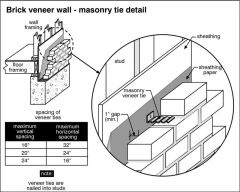
Corrosion-resistant metal strip, used to secure facing masonry to a backup wall or to connect two wythes of a cavity wall. Placed at regular intervals, and mortared into joints during setting. |
Masonry Tie |
|
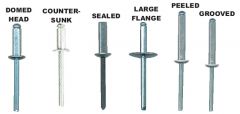
A short pin of a malleable metal, such as iron, steel or copper with a head at one end; used through a hole in both plates and then hammering down the point to form a second head. |
Rivet |
|

An alloy, usually having a lead or tin base, which is used to join metals by fusion; has a melting point that does not exceed 800 degrees F. |
Solder |
|
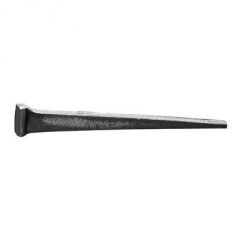
A very heavy nail, over 6 inches in length usually having a rectangular cross section. |
Spike
|
|
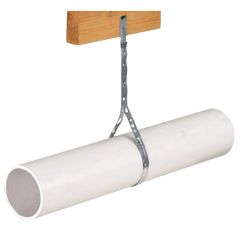
A strap attached to an overhead structure, used to support a pipe, conduit, the framework of a suspended ceiling, or the like. |
Strap Hanger
|
|
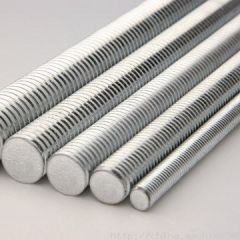
Rounded steel bar or rebar with a threaded end to receive a nut, often cast into a concrete footing to secure a lamp post or bollard. |
Threaded Rod
|
|
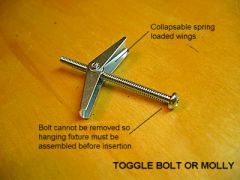
A bolt having a nut with pivoted, flanged wing that dose against a spring when it is pushed through a hole, and open after emerging from the hole; used to fasten objects to a hollow wall or to a wall that is accessible only from one side. |
Toggle Bolt Assembly
|
|
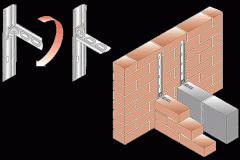
Corrosion-resistant metal strip, used to secure facing masonry to a backup wall or to connect two wythes of a cavity wall. Placed at regular intervals, and mortared into joints during setting. |
Wall Tie |
|
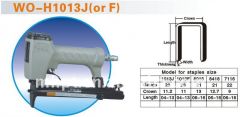
A U-shaped piece of metal wire, with pointed ends, driven into a surface to secure a sheet of material, hold a hasp, etc. |
Staple
|
|
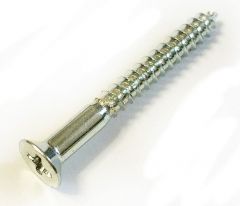
A threaded metal fastener with a pointed end that connects wood members by the friction created between the threads and the wood. Attached with a screw driver. |
Wood Screw
|

